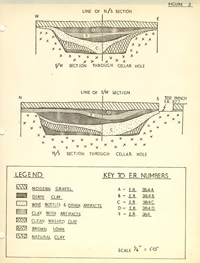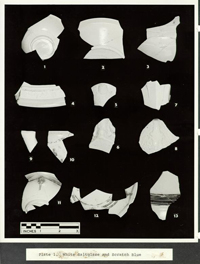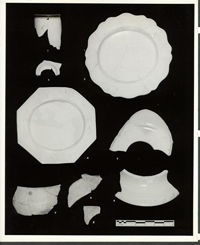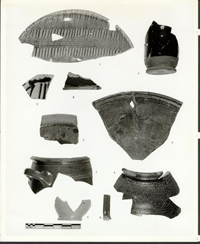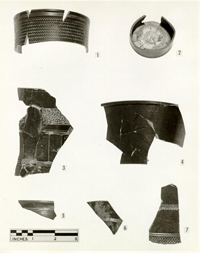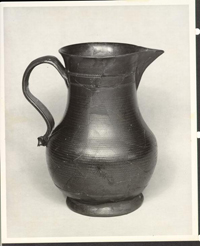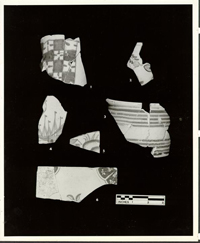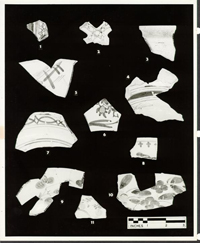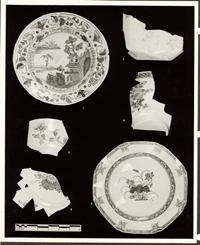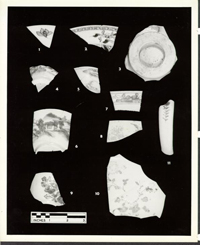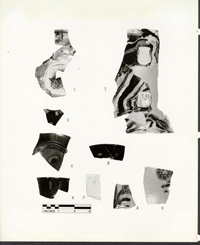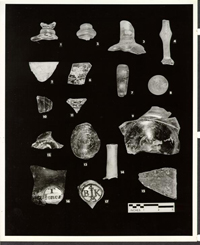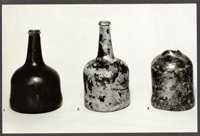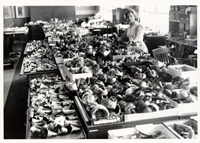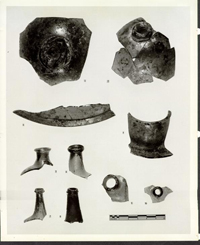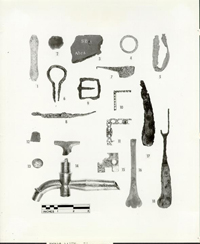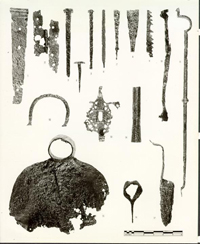United States Postal Service Archaeological Report, Block 15 Building 10BOriginally entitled: "The Post Office Site Block 15, Areas A & B Colonial Lots O & N Report on 1961 Archaeological Excavations Volume II The Artifacts from the Unlined Cellar Area 15A Feature B"
Colonial Williamsburg Foundation Library Research Report Series - 1316
Colonial Williamsburg Foundation Library
Williamsburg, Virginia
1990
THE POST OFFICE SITE
Block 15, Areas A & B
Colonial Lots 0 & NREPORT ON 1961 ARCHAEOLOGICAL EXCAVATIONS
Volume II
THE ARTIFACTS FROM THE UNLINED CELLAR
AREA 15A, FEATURE B
CONTENTS
- Table of Illustrations
- Bibliographic Abbreviations
- Introduction
- Description of Artifacts
- Photographic Negative Numbers
| Figure | 1. | Site plan. |
| 2. | Section through the cellar. | |
| Plate | 1. | White saltglaze and scratch blue. |
| 2. | White saltglaze and Colono-Indian pottery. | |
| 3. | Reconstruction of unidentified white saltglaze vessel. | |
| 4. | White saltglaze, coarseware, delftware, slipware, and German stoneware. | |
| 5. | Slipware, coarseware, and brown stoneware. | |
| 6. | Staffordshire and Nottingham stonewares. | |
| 7. | Staffordshire stoneware pitcher. | |
| 8. | Delftware. | |
| 9. | Delftware. | |
| 10. | Delftware and Chinese export porcelain. | |
| 11. | Chinese export porcelain. | |
| 12. | Whieldon-Wedgwood wares and Rhenish stonewares. | |
| 13. | Table glass and bottle seals. | |
| 14. | Beverage bottles. | |
| 15. | Beverage bottles in course of processing. | |
| 16. | Bell glasses and bottle fragments. | |
| 17. | Small finds. | |
| 18. | Tools and other iron hardware. | |
| 19. | Equestrian, domestic and miscellaneous iron objects. |
BIBLIOGRAPHIC ABBREVIATIONS
- Blacker, J.F.: The A.B.C. of English Salt-Glaze Stoneware. London, 1922.
- British Museum, A Guide to the English Pottery and Porcelain. London, 1904.
- E.C.C. Exhibition, English Pottery and Porcelain. Catalogue of the English Ceramic Circle Exhibition in London. London, 1949.
- Garner, F.H.: English Delftware. London, 1948.
- Graham and Wedgwood, J.M., and H.C.: Wedgwood. Brooklyn, 1948.
- Hay, The Anthony Hay Site, Report on the Excavations of 1960. Volumes I and II by I. Noël Hume.
- Leeds Pattern Book, Designs of sundry articles of Queen's or Cream-colour'd Earthen-Ware manufactured by Hartley, Greens, and Co. at Leeds Pottery. Original in the Library of the Victoria and Albert Museum, London, 1783.
- Noël Hume, Rosewell, I.: Excavations at Rosewell. U.S.N.M. Bulletin 225. Page 153ff.
- Noël Hume, Indian, I.: Quarterly Bulletin of the Archeological Society of Virginia. Volume 17. No. l. September 1962. Page 2ff. An Indian Ware of the Colonial Period.
- Noël Hume, Bottles, I.: The Glass Wine Bottle in Colonial Virginia. Journal of Glass Studies. Volume III, 1961. Page 91.
- Noël Hume, Tutter's Neck, I.: Excavations at Tutter's Neck. U.S.N.M. Bulletin 249, page 29ff.
- Post Office, The Post Office Site. Report on the Archaeological Excavation of 1961. Volume I by I. Noël Hume, November 1961.
- Petersen, H.L.: Arms and Armor in Colonial America. Harrisburg, Pa. 1956.
- Philips, J.G.: China Trade Porcelain. Cambridge, Mass. 1956.
- Ravenscroft, The Ravenscroft Site. Report on the Artifacts Excavated during 1954 by A. Noël Hume. Revised 1962.
- Rackham, B.: Early Staffordshire Pottery. London, 1951
- Travis, The Travis House Site. Report on the Excavations of 1961-1963. Volume I by I. Noël Hume. Volume II by A. Noël Hume.
- Wetherburn Booklet, Colonial Williamsburg Archaeological Series, No. 3. Archaeology and Wetherburn's Tavern by I. Noël Hume, January 1969.
- Wetherburn, The Wetherburn Tavern Site. Report on he Archaeological Excavations of 1965-1966. Interim Report by I. Noël Hume, Volume I, Part 2 by G. Kirk, Volume II, part 1 by A. Noël Hume. Volume II, Part 2 by A. Noël Hume. Volume II, Part 3 by A. Noël Hume.
- Watkins, C.M.: "North Devon Pottery and its Export to America in the 17th Century." U.S.N.M. Bulletin 225, Washington, D.C., 1960.
- Watkins and Noël Hume, C.M., and I.: The Poor Potter of Yorktown. U.S.N.M. Bulletin 249, Washington, D.C., 1967.
INTRODUCTION
The excavation of Block 15, Colonial Lots 0 and N, presently occupied by the U.S. Post office, was conducted in the spring of 1961 by Mr. I. Noël Hume and, during his absence in hospital, by Mr. J. Dunton. Unfortunately the area had been deeply graded within recent memory, resulting in heavy damage to colonial strata and structures.
Three important archaeological features were revealed by the excavations, (Fig. 1.). The apparent earliest, a well shaft,1 had been filled about 1725 by a deposit of household refuse, but natural subsidence caused a topping-up some forty-five years later. The second feature, a cellar hole2 probably belonging to a shop, was the final resting place of a large amount of domestic trash discarded in about 1817-1820, the terminal date provided by the presence of a coin showing relatively little traces of circulation and bearing the date 1817. The third feature, and the subject of this report3, was the unlined cellar hole of a larger building represented only by a number of post holes but probably measuring some 36' x 22'. Sherds from the filling of the cellar mended to fragments from a pair of the holes, indicating that the destruction of the building and the filling of the cellar occurred at approximately the same time.
 Figure 1
Figure 1
There are a number of factors to be taken into account when attempting to determine the approximate date of the filling of the cellar. Firstly, the fact that no building appears in this location on the Frenchman's Map of 1781 confirms its destruction prior to that date; secondly the presence in the hole of 1109 broken beverage bottles, none of which were apparently made after 1765, would suggest a date of about 1770. However, among the ceramic fragments were seven sherds of creamware, made in England from the early 1760's but not yet found in Virginia records before 1769.
One of these sherds is a plate of the pattern called by Josiah Wedgwood in a letter written in 1773, the "new feather edge". It would seem unlikely that such a plate would reach Williamsburg until at least a year or two later, bearing in mind the time lag found in the first known arrival of creamware in Virginia. While the sections shown in Figure 2 might suggest that stratum E.R. 384A represented a later filling, there are a number of crossmending ceramic sherds indicating a roughly similar deposit date for both layers.
Therefore, when all the evidence has been considered, the date for the filling of this cellar hole would appear to be about 1773-1775. This does not mean, however, that everything found in the deposits was relatively new when discarded; merely that it had remained in use until that time.
Plate 1. White Saltglaze and Scratch Blue
- 1.Teabowl, thinly potted with plain, slightly flaring rim and small footring. 2299. E.R. 384C-15.A.
- 2.Section of small bowl or patty pan with flaring sides and sharply everted rim, small footring separated from the flat base by a groove. 1773. E.R. 384C-15.A.
- 3.Rim sherd of tea or punch pot with a vertical collar, below which are two grooves. Below the latter the body slopes sharply downwards to two more grooves, and then incurves to a point where the remains of small holes indicate that the spout was located. 1767. E.R. 384C-15.A.
- 4.Section of straight-sided flower pot tray with flat base, plain rim, thick walls and wedge-sectioned projection immediately below the rim. The upper section of this is decorated with two alternating sprigged motifs, one scroll-like in character, the other based on the Tudor rose. A wall and rim fragment of a similar item was found on the Travis House site [2304. E.R. 422F-14.G.] in a deposit of 1785-90, in association with two bottle seals bearing the letters BIK identical to those found in this deposit. A complete example of a tray of this type is shown in Blacker p. 70. 2203. E.R. 384C-15.A.
- 5.Upper rim fragment of sauceboat containing the end of a strap handle which has been attached to the molded chevron decorated body. This fragment is almost certainly from the same vessel as No. 6 [2305. E.R. 384C-15.A.]. 2300. E.R. 384C-15.A.
- 6.Portion of the spout end of the base of a mold-made sauceboat with a herringbone design running towards the lip, and dot and diaper molding on either side. Similar sauceboats were found on the Anthony Hay site [2301. E.R. 209 and 230C, E.R. 243M and 369E-28.D.] in deposits made between 1765 and 1775. The existence of a similarly decorated sauceboat made in white saltglazed stoneware, but with the double intertwined handles and floral terminals characteristic of creamware suggests that this design was used late in the third quarter of the eighteenth century, (Apollo, Dec. 1956, p. 174). 2300. E.R. 384C-15.A.
- 7 & 8.Neck and shoulder fragments of spill vase with six-sided neck, each with a vertical molded frond. Below the latter, the body swells, each of its six sides has a panel of dot and diaper design separated from its neighbor by a plain spine. A similar vase is illustrated in British Museum, plate 6, No. 5. 1774a, b-E.R. 384C-15.A.
- 9.Rim fragment of small, sharply fluted, star-shaped jelly mold. 2546. E.R. 384A-15.A.
- 10.Rim fragment of pitcher with flaring rim close to which on the interior are two bands of overglaze enamel decoration, the upper consisting of panels of a trellis and diaper pattern in red and black, and below this a solid green band. On the exterior immediately below the rim is an irregularly shaped zone of trellis and diaper in black and green, below which is a floral motif outlined with a fine black line. A similarly painted rim design appears on a coffee pot and a punch bowl illustrated in the E.C.C. Exhibition, Plate 19, No. 103 and Plate 23, No. 96. 1776. E.R. 384C-15.A.
- 11.Teabowl with square-cut footring, plain rim and interior. on the exterior immediately below the rim is an incised cobalt-filled decoration ("scratch blue"), consisting of vertical and horizontal swags. Portions of five similar cups were found in this group [1777-1781. E.R. 384A-15.A.]. 1778. E.R. 384C-15.A.
- 12.Section of saucer with small footring and plain rim, undecorated on exterior, but with incised cobalt-filled ("scratch blue") design of horizontal swags around the rim and vertical and horizontal swags around the plain center. This is probably a matching saucer for the cup No. 11, or one of its five fellows. 1782. E.R. 384A and 391B-15.A.
- 13.Neck fragment of large pitcher with wide multiple cobalt-filled cordoning and plain body flaring sharply outwards from it. This is the later form of this ware in which the cobalt is applied with less care and restraint than in the earlier examples. 1783. E.R. 384C-15.A.
Plate 2. White Saltglaze and Colono-Indian Pottery
WHITE SALTGLAZE STONEWARE
- 1.Section of small tankard, buff body and white clay slip with band of iron oxide at plain rim. There are three cordons immediately above base. It has always been assumed that this dipped ware was not produced long after the first quarter of the eighteenth century, but its frequent discovery in Williamsburg in groups of the early third quarter of that century suggests that production, at least for the colonies, continued later than had hitherto been thought likely. 2307. E.R. 398C-15.A.
- 2.Base of bowl of buff-bodied, white-slipped ware with waisted footring, from which the body swells outwards. 2308. E,R. 384C-15.A.
- 3.Wavy-edged, molded plate with flat base and shallow bowl, rim decorated with dot and diaper zones separated by heart-shaped foliate motifs. 1762. E.R. 384A-15.A.
- 4.Octagonal plate with flat base, shallow bowl and rim with molded dot, diaper and basket design with scroll-like divisions between them. 1763. E.R. 384C-15.A.
- 5. & 6.Base and shoulder fragment of a large vessel of unknown purpose. A reconstruction of this vessel is shown in Plate 3 where further details will be found. 2308. E.R. 384C-15.A.
COLONO-INDIAN POTTERY
(see Noël Hume, Indian Ware)
- 7.Portion of bowl, almost hemispherical with slightly everted rim. The ware is shell-tempered and buff on both faces. 2310. E.R. 384C-15.A.
- 8.Rim portion of bowl with everted rim, the lip topped with gadrooned notching. Traces of shell-tempering are present and both surfaces have been heavily tooled. 2311. E.R. 384C-15.A.
- 9.Rim sherd of small bowl which has been cut diagonally on its inner surface. 2312. E.R. 384A-15.A.
Plate 3.
This drawing is a reconstruction based on seven fragments of a white stoneware vessel found together in one stratum of this deposit. The presence of a number of holes, ½" in diameter in the base precludes its use as either a wine cooler or a chafing dish. No rim sherds were found and the position of the shoulder fragment is conjectural to indicate that the body curves inward towards the neck. This drawing was published in Antiques, Volume LXXXI, No. 1., January 1962, page 113, and readers were invited to suggest uses and similar objects. No replies of consequence were received. A creamware cockle pot made at the Leeds Pottery (Towner, Leeds Pottery. London 1963, Plate 24) has certain similarities but its former owner, Mr. D. Towner, did not consider that the Post office object was for a similar purpose.
2309. E,R, 384A and 384B and 384C-15.A.
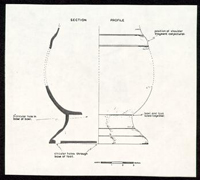 Plate 3. Reconstruction of Unidentified White Saltglaze Vessel
Plate 3. Reconstruction of Unidentified White Saltglaze Vessel
Plate 4. Ceramics, Various
WHITE SALTGLAZE
- 1.Tankard of white saltglaze with straight sides and a slightly flaring base. A wide groove runs immediately below the rim, while a narrow ridge passed just below the top of the handle. At the base of the latter is another pair of grooves below which the base begins to flare. Two more ridges are to be found in the flaring area; a wide groove is placed immediately above the foot. The base is recessed. The multi-reeded, strap handle is smoothed into the body, and at the point where it reaches the central pair of ridges, a tool of uncertain character has been applied to create a series of notches. The paste is a deep cream in color with considerable grey flecking. The closest parallel in shape is the Portobello tankard in the Victoria and Albert Museum shown in Rackham, plate 36. Base diameter: 4 ¾". Height: 6 ½" . 1768. E.R. 384B and C-15.A.
COARSEWARE
- 2.Storage jar of coarse, red, ochre-flecked coarseware with rolled rim, two girth grooves over which a horizontal, round-sectioned handle has been applied. As only a small section of the pot was recovered, the presence of the opposing handle can only be assumed. Probably from the Yorktown (Virginia) Pottery of the Rogers family which was in operation during the second quarter of the eighteenth century, see Watkins & Noël Hume. Height: 7". Rim diameter: approximately 9". Base diameter: 6". 2547. E.R. 384C-15.A.
SLIPWARE
- 3.Small handled mug of buff clay, slipped with a similar clay and then decorated with thin horizontal trails of manganese and inverted into a lead glaze down to the point where the body slopes into the foot. The base is flat, the rim slightly everted and the strap handle is luted to the lower portion of the body. This cup lacks the dots usually associated with this ware, but a similar item on the Travis site [2315. E.R. 579E-14.G.] also has only the lines, Travis, Volume II, Fig. 5, No. 4. 2314. E.R. 384A-15.A.
RHENISH STONEWARE
- 4.Chamber pot of grey, salt-glazed Westerwald stoneware with flattened and slightly down-sloping rim, ornamental grooves and single band of cobalt below rim and above the base. The body is decorated with stamped rosettes and sprigged, crowned lions; each device ringed with cobalt; the handle is reeded and folded at the base. German. Rim diameter: 7". Base diameter: 5 ½". Height: 5 ¼". 2549. E.R. 384C-15.A.
DELFTWARE
- 5.Undecorated wash basin of delftware with everted rim, sharply flaring sides and small footring. Three similar bowls were found at Rosewell, Virginia, in a deposit made between 1763 and 1772. See Rosewell, Fig. 26, No. 1 - 4. Rim diameter: 10". Base diameter: 3 ¾". Height: 4". 2550. E.R. 384C-15.A.
- 6.Bowl of delftware with plain rim and interior (foot missing) and floral decoration in cobalt on two opposing sides of the exterior. Diameter: 7 ½". 2313. E.R. 384A-15.A.
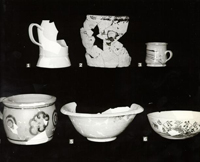 Plate 4. White Saltglaze, Coarseware, Delftware, Slipware, and German Stoneware
Plate 4. White Saltglaze, Coarseware, Delftware, Slipware, and German Stoneware
Plate 5. Slip, Coarse and Brownstone Wares
- 1.Portion of a bat-melded dish of buff clay whose interior was coated with a manganese stained slip and then with a plain slip. Across the latter, a combing rod was trailed allowing the darker slip to return to the surface at intervals. The edge was tooled to produce a pie crust effect and the base is flat. 2251. E.R. 384A and C-15.A.
- 2.Rim sherd of round, bat-molded dish of a coarse pale red clay whose interior was slipped before trails of a manganese-stained slip were applied in a pattern whose character is now undecipherable. The narrow rim has a pie crust edge. 2252. E.R. 384C-15.A.
- 3.Base portion of vessel of a coarse red clay, whose interior and section of the exterior wall above the foot are covered with a clear lead glaze. There is a thick ridge at the junction of the flat base and the wall. Origin uncertain. 2254. E.R. 384A-15.A.
- 4.Cylindrical pot of well-fired red clay, waisted just below rim and above foot and dipped in a manganese glaze, coating the whole interior and the upper part of the exterior. Origin uncertain. 2253. E.R. 384C-15.A.
- 5.Rim sherd of cream pan of gravel-tempered coarseware, with rolled rim, flattened on its interior surface and concave on the exterior. The rim is undercut, the interior of the pan covered with a lead glaze up the junction with the rim. Uneven firing has caused the color of the glazed area to vary from light green to brown. This pan is a product of the North Devon kilns, see Watkins, p. 48. 2256. E.R. 384C-15.A.
- 6.Section through flaring sided pan of coarse red clay, poorly fired. The rim is rolled and grooved on the interior which has been covered with a clear lead glaze. The base is flat and a trail of glaze across its exterior indicates that after glazing the pan was everted on its rim in the kiln. 2255. E.R. 384C-15.A.
- 7.Rim portion of stoneware jar with everted rim, flattened on the upper surface and recessed on the interior to take a lid. Two inches below the rim a round-sectioned horizontal handle (pierced once) is crudely luted onto the body over three girth grooves. Both surfaces are slipped with a ferrugineous clay slip which has burnt on the exterior to a mottled light brown and on the interior to a flat orange. The jar was somewhat over-fired. Two similar jars were excavated on the Anthony Hay site [1858-28.D. and 1859-28.D], another on the Ravenscroft site, see Ravenscroft plate 5, No. l, all in deposits made between 1750 and 1780. 2443. E.R. 384C-15.A.
- 8.Rim portion of large globular brownstone jar with steeply everted rim, recessed on its interior surface to take a lid. There is a cordon slightly below the junction of the rim and the sharply incurving body, and three more cordons lower on the shoulder. The exterior surface and the area immediately below and including the rim are slipped with a ferrugineous slip which has given the exterior a rich mottled brown appearance. 2257. E.R. 384C-15.A.
- 9.Base of small grey stoneware vessel with sides flaring out sharply from a crude foot ring. The base is flat and there is a single groove on the body. 2245. E.R. 384C-15.A.
- 10.Lower portion of strap handle of tankard, the main part of which has been dipped in a ferrugineous slip, while the lower bears traces of the white slip with which the bottom section of the tankard was coated. The Stoke-on-Trent Museum has identified a similar fragment as a product of the Burslem kilns. 2259. E.R. 384A.-15.A.
- Other fragments from this group (inadequate for illustration), include portions of two tankards of the type known as "Fulham" but made at other London potteries throughout the eighteenth century, rim and base sherds of a pipkin similar to that found at the Coke Garrett site [2258. E.R. 140-27.B.] in a context of 1740-60 and believed to be a product of the Yorktown kilns.
Plate 6. Staffordshire and Nottingham Stoneware
STAFFORDSHIRE STONEWARES
- 1.Rim of straight-sided tankard or cylindrical pitcher neck thinly potted with lustrous surface and close horizontal bands of wavy rouletted lines. The rim is plain and two grooves separate it from the body. This object has the same origin as the pitcher [2231. E.R. 384A-15.A.]1, which is believed to be Staffordshire. 2232. E.R. 384A-15.A.
- 2.Base of small straight-sided coffee can with a single groove above the base, which is set within a sloping foot. This is similar in lustre and glaze to No. l and to the pitcher shown in Plate 7. 2233. E.R. 384A-15.A.
NOTTINGHAM STONEWARE
- 3.Body portion of straight-sided tankard with lustrous exterior and white layer between the "glaze" and the body, generally assumed to denote a Nottingham origin and seen in items 3-7. The rim and the zone below it are plain, then a band of rough-cast decoration followed by another plain band. The body area consists of a band of wide vertical facets below which is another plain zone. The multi-reeded strap handle is attached at the rough cast and faceted zones respectively, the lower end is pinched in the manner of white saltglazed stoneware. 2234. E.R. 384C-15.A.
- 4.Portion of a straight-sided, oval dish with lustrous surface. The rim is slightly rolled, the base is flat and the interior has pronounced potting rings. The major part of a similar dish was excavated at the Wetherburn site in a deposit made post 1760, see Wetherburn, Volume II, Part 3, Fig. 13, [3908. E.R. 1130G and J-9.N. 2235. E.R. 398B-15.A.
- 5.Rim sherd of globular bowl with lustrous surfaces and sharply everted rim and cordon at junction of rim and body. 2316. E.R. 384A and C-15.A.
- 6.Rim sherd of flaring bowl with lustrous surface. Below the plain rim are two cordons. 2318. E.R. 384A015.A.
- 7.Body fragment of straight-sided vessel decorated with two horizontal bands of incised zig-zag lines, one narrow and the other only partially present. 2317. E.R. 384C-15.A.
Plate 7.
Pitcher of brown salt-glazed stoneware with rich brown lustrous surface of the type known as "Nottingham" stoneware, but without the white layer between the glaze and body often considered to identify a true Nottingham product. The pitcher has a globular body flaring from a foot and incurving again to a neck. The spout is acutely angled and the strap handle multi-ribbed and thumbed at its lower extremity. White salt-glaze pitchers of this shape often bear enamelled dates and known examples range between 1755 and 1764. A brownstone pitcher with the incised date 1760 is shown in Blacker, Page 9, but the poor quality of the drawing makes a positive comparison impossible.
Height: 7 7/8".
Gt. diameter: 5".
Rim diameter: 4".
2231. E.R. 384A-15.A.
Plate 8. English Delftware
- 1.Portion of straight-sided tankard with slightly everted rim and plain interior. The exterior has a crudely painted, cobalt, chequer board design, alternate squares being infilled while the remainder are embellished with four lines partially quartering them. 2275. E.R. 384A-15.A.
- 2.Portion of straight-sided tankard, plain on interior. The exterior has a floral design consisting of manganese stalks with cobalt leaves and manganese berries. There is a single cobalt line close to the plain rim. 2276. E.R. 384A-15.A.
- 3.Section of cylindrical drug jar with everted rim and flat recessed base. The interior is plain; while the exterior is decorated with two groups of five crudely painted cobalt bands. 2277. E.R. 384C-15.A.
- 4.Central portion of tile, unglazed on the back, and the front with a scene showing three ships moored behind an arched quay. A similar tile was found in a fireplace at Bristol, suggesting that they were made in that city, see "Bristol Delft Tiles in Fireplaces found at Beaufort Place, Bristol, 1958," Proceedings of the Bristol and Gloucester Archaeological Society, Page 159. A corner identical to that of the Beaufort Place tile was found in the same group but is not illustrated. 2278 .E.R. 384C-15.A.
- 5.Edge portion of tile with cobalt-painted design of a house and rocks with sprouting plants. This is part of the same design as appears on No. 4, whose origin is discussed therein. 2280. E.R. 384A-15.A.
- 6.Upper portion of tile with plant or flowers in center, the corner design of a double scallop painted in dark blue, except for a small reserve flower in the middle of each. 2279. E.R. 384C-15.A.
Plate 9. English Delftware
- 1.Body fragment of fluted bowl decorated in blue with vertical stripes and a zone of double line herringbone pattern. A sherd of a similarly shaped and decorated bowl was found at the Wetherburn site [6040. E.R. 1123P-9.N.], and a bigger fragment from the excavation of the Blair stables has the same basic features of shape and decoration [6041-29.H.4]. 2266. E.R. 384C-15.A.
- 2.Small body fragment of bowl with lattice sides decorated both internally and externally with a pair of blue lines emphasizing the basket design. On the interior only, these lines are filled in with a "cracked ice" motif also in blue. Another fragment of this vessel was found in the filling of a post hole on the same site [2267. E.R. 392-15.A.]. A plate illustrated in Garner, Plate 80B, has a similar decoration which is attributed to "Bristol, about 1760". 2267. E.R. 384C-15.A.
- 3. & 4.Base and rim sherds of chamber pot with everted rim and exterior glaze in poor condition. Traces remain of a cobalt decoration, perhaps in the form of horizontal bands. In one area the glaze has pulled away from the body, causing the cobalt line to curve with it. Flat base within a square-cut foot ring and the sides out-curving from it. The walls are decorated with a group of two narrow, one wide and three narrow crudely applied cobalt bands. A rim sherd of a similarly shaped and decorated chamber pot was found at the Coke-Garrett House, [2269. E.R. 132-27.A.] and was considered to have been manufactured at least thirty years before it was deposited with other trash in the period 1760-1770. 2260a & b. E.R. 384C-15.A.
- 5.Wash basin fragment with everted rim, plain on exterior and with interior cobalt design of a fence (?) painted in the same technique and palette as bowl fragments from the Anthony Hay site [2221. E.R. 364B-24.D.] and the Ravenscroft site [2222-28.F.4], both from deposits made in the years between 1770-1785. 2270. E.R. 384C-15.A.
- 6.Body fragment of bowl decorated on interior with diamond-shaped arrangement of four cobalt dashes and on exterior with a cobalt floral design. 2271. E.R. 398C-15.A.
- 7.Section through plate with narrow rim decorated in cobalt in a design of intersecting and opposite facing swags enclosed by lines and with two more lines at the base of the bowl. A fragment with identical decoration and similar small rim is illustrated in Transactions of the English Ceramic Circle, No. 4, 1937, Page 56, along with other fragments found on the site of a delftware pottery in Fore Street, Lambeth, London, and considered by the author of the paper, Dr. F. H. Garner, to be a product of that area. 2272. E.R. 398C-15.A.
- 8.Rim fragment of plate decorated on upper surface with spear-head pattern common on Chinese porcelain of the period; below is a portion of a floral design. A plate with a similar design was found at the James Geddy site in a deposit made about 1755. 2273. E.R. 384A-15.A.
- 9.Rim and body sherd of small bowl, apparently plain on the interior and with hand-painted, polychrome floral decoration on exterior. The latter consists of red berries, yellow flowers, green stalks and leaves, the latter with black veining and with the green color applied after the same leaves had been painted in blue and fired. This is the Fazackerley style of decoration used commonly in the Liverpool area between 1755-1765. 2236. E.R. 384A-15.A.
- 10.Rim and body sherd of small bowl with plain rim and manganese-spotted exterior. The interior is decorated with a hand-painted floral design of yellow and blue "flowers" and green stalks and leaves, the latter being applied in green over a blue base which had already been fired. A bowl of similar size and external appearance was excavated on the Anthony Hay site [2238. E.R. 200-28.D.] in a deposit of 1775-1780. This is the Fazackerley style of decoration used commonly in the potteries of the Liverpool area between 1755-1765. 2237. E.R. 384C-15.A.
- 11.Portion of base of saucer with triangular-sectioned foot and plain exterior. The interior has a hand-painted decoration of extremely thin manganese stalks, cobalt leaves and pale yellowish-green "berries". Two cobalt circles enclose the apparently plain central area. 2247. E.R. 384A-15.A.
Plate 10. English Delftware and Chinese Export Porcelain
DELFTWARE
- 1.Plate with sloping rim and recessed base. The exterior plain except for three equidistant wavy lines painted close to the junction of the bowl and rim. The upper surface of the latter has a dark cobalt repeating design of floral spray and a moth-like insect with two solid circles in the spaces on either side of the head. The shoulders have a similarly colored design of alternating diamond trellis and stylized flowers. The center is filled with a chinoiserie scene including a multistoried pagoda, rocks and tree. Fragments of at least one other identical plate were found in this group. Rim fragments from similarly decorated plates were excavated on the site of the Norton-Cole house on Duke of Gloucester Street, Williamsburg, and on the neighboring James Geddy site [E.R. 1328-19B]. 2281. E.R. 384-15.A.
CHINESE EXPORT PORCELAIN
- 2.Portion of base of octagonal tureen with alternate long and short sides. There is a ridge immediately above the unglazed base along which a single underglaze blue line runs and there are two similar lines immediately above the point where the body of the tureen swells outwards. Traces of a floral-type underglaze blue decoration can be seen on the exterior walls. A similarly shaped tureen illustrated in Phillips, Plate 6, Page 72, was dated by amorial evidence to the years 1760-1770. 2283. E.R. 384C-15.A.
- 3.Section of bowl with plain rim and heavy foot ring, unglazed on its extreme edge. There is an underglaze blue band of decoration close to the rim, consisting of a diaper area adjoining an oval cartouche whose contents cannot be identified from the sherd. Below is a large flowering plant and a similar device appears in the center of the bowl. The rim is brownedged and there is a single blue line immediately below it and another at the base of the wall. Height: 4-1/8". 2284. E.R. 384C-15.A.
- 4.Section of medium sized bowl with plain, brown-edged rim with band of diamond and diagonal underglaze blue cross decoration close to it on interior. The exterior is plain except for stylized lotus and peony motif. 2285. E.R. 384C-15.A.
- 5.Section of octagonal plate with sloping rim and unglazed foot, the former is decorated with an underglaze blue floral design; there is a single line around the lower edge of the bowl, the center of the latter being filled with a stylized lotus plant. 2286. E.R. 384C-15.A.
- 6.Octagonal plate with everted rim which is brown-edged and bordered by an underglaze blue, diamond-type motif interspersed at the corners with a moth-like device. In the center an alternating diaper and floral design encircles a stylized lotus plant. The base is recessed within the unglazed foot. 2288. E.R. 384C-15.A.
Plate 11. Chinese Export Porcelain
- 1.Small rim sherd of plate decorated on upper surface with an underglazed blue lotus bud, outlined in a dark blue and poorly washed with a lighter shade. 2289. E.R. 384A-15.A.
- 2.Fragment of round plate, brown-edged and with a diaper band enclosing a floral spray. The sides of the plate also have a diaper design alternating with oval cartouches whose decoration cannot be ascertained due to the size of the sherd. 2290. E.R. 384C-15.A.
- 3.Base of medium-sized bowl with extremely wide and thick unglazed foot ring. In the bottom of the bowl is a poorly executed underglazed blue rosette. 2291. E.R. 384C-15.A.
- 4.Base of tea bowl with deep, square-cut foot ring, the latter and the base being unglazed. The interior of the cup is plain, while the exterior has a landscape design in underglaze blue. Similar bowls were excavated at the Chiswell site, mostly discarded between 1740 and 1760. 2293. E.R. 384A-15.A.
- 5.Fragment of small tea bowl, thinly potted and with slightly everted rim. Close to the latter's internal surface is a narrow band of blocks of opposite facing, diagonal, underglaze blue lines. The exterior of the cup has a landscape executed in a very pale underglaze blue. Foot missing. 2292. E.R. 384C-15.A.
- 6.Section of small sloping-sided bowl with slight foot ring, unglazed at its lower edge. There are two lines close to the rim on the interior, while the exterior is covered with an oriental landscape; all decoration in underglaze blue. 2294. E.R. 384C-15.A.
- 7.Section of small tea bowl with wedge-sectioned foot ring, unglazed at its lower edge. The interior of the bowl is plain, but the exterior has a floral design, the larger leaves in underglaze blue, while the flowers and the smaller leaves have been added over the glaze in red and gilt. 2295. E.R. 384C-15.A.
- 8.Rim sherd of large fluted bowl decorated in famille rose enamels on the exterior and with an overglaze red band enclosing alternating zones of trellis and floral motifs at the interior. 2296a,b. E.R. 384A-15.A.
- 9.Saucer fragment with wedge-sectioned foot ring, flatbase and plain exterior. The interior is decorated with famille rose enamels; plain back. 2297. E.R. 384C-15.A.
- 10.Base fragment of plate decorated on interior with famille rose enamels; plain back. E.R. 384C-15.A.
- 11.Portion of handle of large pitcher or tankard decorated in overglaze red floral spray running vertically up the handle which broadens towards the top. 2298. E.R. 384C-15.A.
Plate 12. Whieldon-Wedgwood Wares and Rhenish Stonewares
WHIELDON-WEDGWOOD WARES
- 1.Small bowl of cream-colored earthenware decorated with manganese and iron glazes (clouded ware), with two narrow grooves below the exterior of the rim and another above the absent foot ring. 1784. E.R. 384A & C-15.A.
- 2.Section of straight-sided agate ware tankard, thinly potted with single ridges close to rim, and immediately below handle and double ridge close to slightly flaring base. The handle is multi-ribbed; the terminal pinched and thumb pressed; the base is recessed and very thin. Its colors are dark and light brown, yellow and blue. For similar examples, see Rackham, pl. 56 and Country Life, CXXXLX 3338, February 23, 1961, Page 403. 1760. E.R. 384A-15.A.
- 3.Rim fragment of Jackfield-type teapot of black glazed stoneware with collar and shoulder supporting a highly globular body. 1789. E.R. 384A-15.A.
- 4. & 5.Two fragments of saucer of Jackfield-type plain rim and well-formed foot ring. 1787a. E.R. 384A-15.A.
- 6.Portion of small tea bowl of Jackfield-type with slightly flaring rim. 1786a. E.R. 384A-15.A.
- 7.Rim of plate with the design referred to by Josiah Wedgwood as "New Feather Edge" in November 1773. A plate with a similar decoration is shown in Graham & Wedgwood, Plate 67, No. 28, and attributed to "Etruria 1772." A strawberry bowl with a similar design but not within the "Royal" pattern border as in the case of the plate is illustrated in the Leeds Pattern Book of 1783, No. 86. 2320. E.R. 384A-15.A.
Plate 13. Table glass and Bottle Seals
- 1.Lower portion of dram of jelly glass with knop and plain foot. 2330-E.R. 384C-15.A.
- 2.Annular knop from wine glass. 2331-E.R. 384C-15.A.
- 3.Lower portion of heavy straight stem and crudely made foot from large goblet. 2332-E.R. 384C-15.A.
- 4.Portion of multi-spiral air-twist stem with knop. 2333-E.R. 384C-15.A.
- 5.Fragment of plain, trumpet-shaped wine glass bowl. 2334-E.R. 384C-15.A.
- 6.Rim fragment of wine glass with wheel engraved decoration of grape vine. 5523-E.R. 384C-15.A.
- 7.Clear glass handle from pitcher or small tankard. 5524-E.R. 384C-15.A.
- 8.Clear glass, mushroom-shaped upper portion of decanter stopper containing row of nine oval tears each surmounted by a round one. 5525-E.R. 384A-15.A.
- 9.Base fragment of clear glass, round decanter, crude pontil mark. 5526-E.R. 384C-15.A.
- 10.Small body fragment of clear glass, mold-made flask (?) with vertical ribs on the exterior. 2376. E.R. 384-15.A.
- 11.Fragment of clear glass, molded vessel with exterior diamond molding similar to that found on window glass at Rosewell, see Rosewell, Page 118, Fig. 17. 2377. E.R. 384C-15.A.
- 12.Base of small green glass, mold-made cylindrical vessel with ribs radiating from the pontil mark. 5527. E.R. 384C-15.A.
- 13.Base of small clear glass, mold-blown perfume bottle with ribs radiating from the pontil mark. The base of a similar vessel was found at the Coke-Garrett site in a deposit made about 1760 [2383. E.R. 140-27.B.] 2384. E.R. 384C-15.A.
- 14.Tall cylindrical neck of pale blue-green phial somewhat similar in color to the square blue-green bottles common in the second half of the eighteenth century such as the example found at the James Geddy House in a deposit made c.1760 [5528. E.R. 987M-19.B.]. 5529. E.R. 384C-15.A.
- 15.Fragment of mirror plate, one edge crudely finished, but ground on the other side. 5530. E.R. 384C-15.A.
- 16.Seal from green glass wine bottle bearing the legend "T Jones," apparently Colonel Thomas Jones who came to Virginia in 1702 with his brother Frederick Jones. The latter's house at Tutter's Neck, James City County, was excavated by the Archaeological Department of Colonial Williamsburg in 1960, see Tutter's Neck, Page 178, Fig. 17. Colonel Thomas Jones owned various properties in Williamsburg before he and his wife settled in Hanover County in 1750. The first of these, lot 54, the site of the Raleigh Tavern, was in his possession from 1714/1715 to some time prior to 1742. Lot 47 (the site of the Pitt-Dixon house) was his apparently for only a few years between 1719 and 1722. He married in 1725 the owner of Block 31 and they resided there for the subsequent quarter century. The shape of the bottle fragment bearing the seal suggests a date of manufacture between 1720 and 1730. 2443. E.R. 384C-15.A.
- 17.Bottle seal of dark green metal bearing the initials BIK with the I being used as the central shaft of a Chi-Rho style merchant's mark. Similar seals have been found at the Governor's Palace [2393-20.A.], the Capitol [2394-8.C.], the Travis House site [see Travis, Volume II, Figures 11 to 25, 2386-E.R. 422F-14G and also 2396. E.R. 4221-14G] and the Chiswell site [6045. E.R. 1636E-2.H.]. In each case the shape of the bottle from which the seals came indicates a date of manufacture between 1730 and 1740. It is conceivable that the B and K could identify the Bowdoin and Kendell families from the Eastern Shore of Virginia. The possibility that both the artifacts recovered at the Travis House in the area where the bottle seal was found (E.R. 422F-14.G) and the artifacts in this cellar hole have an association with the Custis family (also from the Eastern Shore) which is discussed in detail in Travis House, Volume I, page 67 ff. 2385. E.R. 384A-15.A.
Plate 14. Beverage Bottles
- 1.Beverage bottle of medium green metal with tapering neck and sloping shoulder, down-tooled string rim and basal kick. See Noël Hume, Bottles Figure 4, No. 13. Base diameter: 5 ¼ inches. Date of manufacture: 1730-1745. 2737. E.R. 384D-15.A.
- 2.Beverage bottle of dark green metal with tall neck, up-tooled string rim, slightly inverted mouth. The basal kick is wide and flattened. See Noël Hume, Bottles, Figure 4, No. 16. Height: 6 inches. Base diameter: 4 ¼ inches. Date of manufacture: 1750-1765. 2328. E.R. 384C-15.A.
- 3.Beverage bottle of dark green metal (neck missing) and taller than No. 2 in the body. See Noël Hume, Bottles, Figure 5, No. 19. Existing height: 6 inches. Base diameter: 4 ¼ inches. Date of manufacture: 1750-1770. 2329. E.R. 384C-15.A.
Plate 15. Beverage Bottles
A total of 1,109 identifiable beverage bottle bases was recovered and are shown in course of processing. 81% were manufactured between 1730 and 1765 and none later than 1770.
Plate 16. Bell Glasses and Bottles
- 1.-3.1-3. Two knobs and one folded rim fragment from large bell glasses made from the normal bottle glass metal. Fragments of at least 12 such glasses were found in this deposit and are believed to have come from the John Custis site [4.B], for details of the possible connection see Plate 13, No. 17. Fragments of similar glasses have been excavated in Williamsburg at the Governor's Palace, Peter Hay's Shop, the Raleigh Tavern, the Wythe House and John Carter's Store. No. 1. 6046. E.R. 384C-15.A. 2. 6047. E.R. 384C-15.A. 3. 6043. E.R. 384C-15.A.
- 4.Fragments of thick glass vessel, possibly part of a fly-trap. 2322. E.R. 384C-15.A.
- 5.Neck of large cylindrical bottle, the shoulder sloping, the neck expanded. 6048. E.R. 384C-15.A.
- 6.Neck of tall preserves bottle, similar to that found at Wetherburn's Tavern, see Wetherburn, Vol. II, Part 3, Figure 18; or Wetherburn Booklet, Figure 21. 6049. E.R. 384C-15.A.
- 7.Neck of half bottle with pronounced wrythen striations, V-sectioned string rim. 2325. E.R. 384C-15.A.
- 8.Neck of wine bottle with down-tooled string rim and brass wire still attached. 2326. E.R. 384C-15.A.
- 9.Neck of snuff bottle. 2323. E.R. 384C-15.A.
- 10.Neck of small case bottle. 2324. E.R. 384C-15.A.
Plate 17. Small Find
- 1.Medium-sized pipe clay wig curler with impressed stamp "WB" surmounted by a crown on each end. 2215. E.R. 384A-15.A.
- 2.English rifle flint of greasy grey color and with signs of crude knapping. 2401. E.R. 384A-15.A.
- 3.Corner fragment of writing slate on which has been deeply incised "SB" below this, "Abcd". 2399. E.R. 384C-15.A.
- 4.Small lead ring, flattened on exterior surfaces. 2407. E.R. 384C-15.A.
- 5.Fragment of drawn lead from leaded window; a number of similar fragments were found in the same deposit indicating the possible presence of casement windows in a structure on or close to the site. 2403. E.R. 384C-15.A.
- 6.Iron Jew's harp (tang missing). 2410. E.R. 384A-15.A.
- 7.Small iron object of uncertain use with a semi-circular section joined to a pointed tang which is burred over at its extremity. Two similar objects were found with this one [2404, 2405-E.R. 384A-15.A.] and it is thought that they might be worn examples of the knife-like items found at Rosewell, (see Rosewell, Figure 36), Tutter's Neck, (see Tutter's Neck, Figure 16, No.l2) and several sites in Williamsburg. 2407. E.R. 384A-15.A.
- 8.Toy, iron, ice skate. 2409. E.R. 384A-15.A.
- 9.Square iron buckle, possibly from harness. E.R. 384A-15.A.
- 10.Portion of rectangular brass shoe buckle with notched design on upper surface. 2398. E.R. 384A-15.A.
- 11.Portion of rectangular brass shoe buckle, with open work design of interlocking quatrefoil motifs. 2397. E.R. 384A-15.A.
- 12.Small brass thimble with end and side indentations, domed top. 2400. E.R. 384A-15.A.
- 13.Brass button with oval shank, convex front, two cordons close to edge. 5533. E.R. 384C-15.A.
- 14.Brass spigot of traditional form with three-sided projection behind the spout against which the bottles were lodged while being filled; marks of rough filing on the tapering after-section of the tube. Flattened top to key which has broken off while in the spigot. 5531. E.R. 384C-15.A.
- 15.Half of square brass hinge with three holes for attachment by means of countersunk nails or screws. 2402. E.R. 384C-15.A.
- 16.Trefoil-ended handle of latten spoon, no marks. 5532. E.R. 384C-15.A.
- 17.Iron razor with two-piece bone handle attached by three iron rivets at the tang. 5532. E.R. 384C-15.A.
- 18.Two-tined fork with flat tang and two-piece bone pistol-grip handle attached by three iron rivets. 2408. E.R. 384A-15.A.
Plate 18. Tools and Other Iron Hardware
- 1.Portion of iron strap hinge (end missing) with three unevenly spaced holes for attachment. 2411. E.R. 384C-15.A.
- 2.Fragmentary H of HL iron hinge. 2412. E.R. 384C-15.A.
- 3.Large iron spike with square head. 2413. E.R. 384C-15.A.
- 4.Iron spike with burred-over square head. 2414. E.R. 384C-15.A.
- 5.Small wedge-ended iron spike with large square head. 2415. E.R. 384C-15.A.
- 6.Portion of triangular iron file. A quantity of these were found at the site of the Anthony Hay cabinetmaking shop on Nicolson Street where it is believed that they were used to sharpen saw teeth during the working life of the shop which terminated in or about 1780, see Hay, Volume III, Part 1, Fig.7, Nos. 11-17. 2416. E.R. 384A-15.A.
- 7.Paring chisel, iron with octagonal shoulders and square-sectioned tang. Similar chisels were found at the Anthony Hay cabinet-making shop, see Hay, Volume III, Part 1, Fig. 8, Nos. 1-7. 2417. E.R. 384C-15.A.
- 8.Forming chisel, most of handle missing. 5576. E.R. 384A-15.A.
- 9.Portion of blade of small saw with exceptionally large teeth. 2418. E.R. 384C-15.A.
- 10.Bar, probably the largest and center of a circular grating with portion of the welded exterior circle still attached. 2419. E.R. 384C-15.A.
- 11.One-half of fire tongs, spectacle-type shoulder, round-sectioned with knop at half-way point between flattened end and shoulder. 2420. E.R. 384C-15.A.
- 12.Round loop from padlock. 5577. E.R. 384C-15.A.
- 13.Fragment of sword hilt comprising part of the knuckle bow and the pierced iron guard; probably a cutting sword, see Peterson, Plate 86, where a similar item is attributed to the early seventeenth century. 2422. E.R. 384C-15.A.
- 14.Small length of circular iron pipe, flaring at one end. 5570. E.R. 384C-15.A.
- 15.Round hoe with fragmentary blade, socket slightly tapering and extending ink a flat triangular spine on the upper surface of the blade. No evidence of a maker's mark. 2423. E.R. 384A-15.A.
- 16.Handle fitting for a scythe. 2425. E.R. 384A-15.A.
- 17.Iron blade from pair of shears, the shank flat on the inside, convex on the outside. 2421. E.R. 384A-15.A.
Plate 19. Equestrian, Domestic and Miscellaneous Iron objects
- 1.V-mouthed curb bit with one fragmentary rein loop and angled tongue-piece. 2426. E.R. 384C-15.A.
- 2.Curb bit with straight bar, upper portion missing. 2427. E.R. 384C-15.A.
- 3.Jointed curb bit. 2428. E.R. 384A-15.A.
- 4.Stirrup with grid-type foot plate, round-sectioned sides and oval leather loop. 2429. E.R. 384C-15.A.
- 5.Horseshoe with fullering, three nail holes per side, slightly spread at the heels. 5578. E.R. 384C-15.A.
- 6.Wagon harness hook with oval head in opposite plane to curved hook. 2430. E.R. 384A-15.A.
- 7.Rectangular buckle of heavy iron with roller for leather strap (tang missing). A similar buckle was found on the Anthony Hay site in a deposit made c.1775, [2432. E.R. 362B-28.D.)], see Hay, Volume III, Part 1, Figure 63, No. 18. 2431. E.R. 384A-15.A.
- 8.Fragment of iron spur, the rowel encased in rust which cannot be removed without destroying its character. 5569. E.R. 384C-15.A.
- 9.Unidentified object possibly part of an oven door consisting of a straight-edge on which is welded a hinge and below (or above) a bar with two rounded ends which could slide back and forth. To the bar containing the latter is added a projection which, being encased in wood, was probably a handle. 2434. E.R. 384C-15.A.
- 10.Unidentified iron object comprising a small hinge riveted to a blade-shaped plate from which projects a round-ended, acute-angled hook of uncertain purpose. 2435. E.R. 384A-15.A.
- 11.Lump of iron slag or waste found in same deposit as the crucible fragment (No. 12) and similar to material found in the secondary filling of the well on this site, see Post Office, Volume I, Page 13. 2433. E.R. 384C-15.A.
- 12.Fragment of triangular mouthed crucible showing considerable evidences of use. 2434. E.R. 384C-15.A.
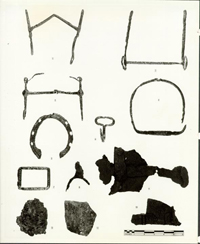 Plate 19. Equestrian, Domestic and Miscellaneous Iron Objects
Plate 19. Equestrian, Domestic and Miscellaneous Iron Objects
Photographic Negative Numbers
| Plate | 1. | 62-GR-3006-5. |
| 2. | 62-GR-3007-15 | |
| 4. | 62-GR-3007-9. | |
| 5. | 62-GR-3007-5. | |
| 6. | 62-GR-3006-2. | |
| 7. | 62-GR-3007-4. | |
| 8. | 62-GR-3007-10 | |
| 9. | 62-GR-3007-2. | |
| 10. | 62-GR-3006-4. | |
| 11. | 62-GR-3007-13 | |
| 12. | 62-GR-3007-7. | |
| 13. | 62-GR-3007-6. | |
| 14. | 62-GR-3006-6. | |
| 15. | 68-CK-2840. | |
| 16. | 62-GR-3007-1. | |
| 17. | 62-GR-3007-12 | |
| 18. | 62-GR-3007-8. | |
| 19. | 62-GR-3007-3. |
